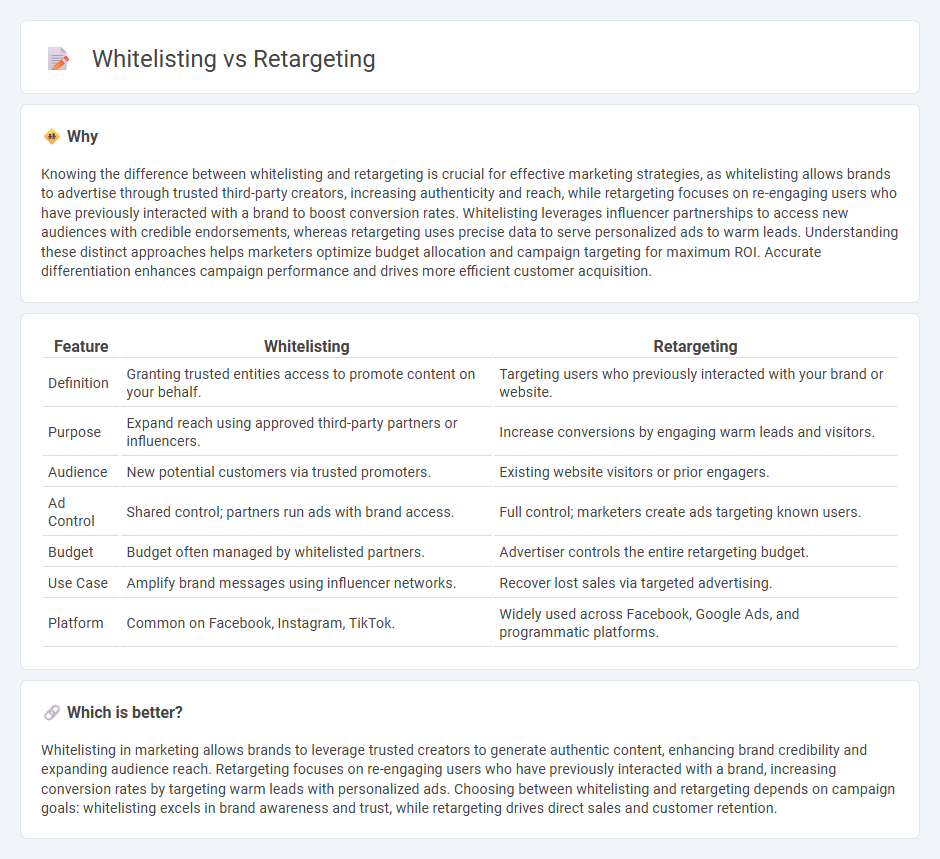
Whitelisting in marketing involves pre-approving certain publishers or platforms to display ads, ensuring brand safety and targeting accuracy. Retargeting focuses on re-engaging users who have previously interacted with a brand, increasing conversion rates through personalized ads. Discover the strategic advantages of whitelisting versus retargeting to optimize your campaign performance.
Why it is important
Knowing the difference between whitelisting and retargeting is crucial for effective marketing strategies, as whitelisting allows brands to advertise through trusted third-party creators, increasing authenticity and reach, while retargeting focuses on re-engaging users who have previously interacted with a brand to boost conversion rates. Whitelisting leverages influencer partnerships to access new audiences with credible endorsements, whereas retargeting uses precise data to serve personalized ads to warm leads. Understanding these distinct approaches helps marketers optimize budget allocation and campaign targeting for maximum ROI. Accurate differentiation enhances campaign performance and drives more efficient customer acquisition.
Comparison Table
| Feature | Whitelisting | Retargeting |
|---|---|---|
| Definition | Granting trusted entities access to promote content on your behalf. | Targeting users who previously interacted with your brand or website. |
| Purpose | Expand reach using approved third-party partners or influencers. | Increase conversions by engaging warm leads and visitors. |
| Audience | New potential customers via trusted promoters. | Existing website visitors or prior engagers. |
| Ad Control | Shared control; partners run ads with brand access. | Full control; marketers create ads targeting known users. |
| Budget | Budget often managed by whitelisted partners. | Advertiser controls the entire retargeting budget. |
| Use Case | Amplify brand messages using influencer networks. | Recover lost sales via targeted advertising. |
| Platform | Common on Facebook, Instagram, TikTok. | Widely used across Facebook, Google Ads, and programmatic platforms. |
Which is better?
Whitelisting in marketing allows brands to leverage trusted creators to generate authentic content, enhancing brand credibility and expanding audience reach. Retargeting focuses on re-engaging users who have previously interacted with a brand, increasing conversion rates by targeting warm leads with personalized ads. Choosing between whitelisting and retargeting depends on campaign goals: whitelisting excels in brand awareness and trust, while retargeting drives direct sales and customer retention.
Connection
Whitelisting in marketing involves approving specific content or advertisers to ensure trusted engagement, while retargeting focuses on displaying ads to users who have previously interacted with a brand. This connection enables marketers to use whitelisted data sources to create highly targeted retargeting campaigns, improving ad relevance and conversion rates. Leveraging whitelisted audiences enhances retargeting accuracy by filtering high-quality prospects and reducing ad spend on uninterested users.
Key Terms
Audience Segmentation
Retargeting targets users who have previously interacted with a brand, allowing precise audience segmentation based on behaviors like website visits or past purchases. Whitelisting focuses on partnering with trusted publishers or influencers to reach a broader but curated audience segment aligned with brand values. Explore the nuances of audience segmentation strategies to maximize campaign effectiveness.
Ad Placement Control
Retargeting focuses on reaching users who have previously interacted with a brand by tracking their online behavior, allowing precise ad placement based on user interest data. Whitelisting, on the other hand, grants advertisers control over specific websites or apps where ads are shown, ensuring placements align with brand safety and target audience relevance. Explore more about how ad placement control strategies impact campaign performance and ROI.
Conversion Tracking
Retargeting targets users who have previously interacted with a brand to increase conversion rates through personalized ads, leveraging pixel data and customer behavior insights. Whitelisting involves approving specific websites or apps to display ads, ensuring brand safety and higher ad performance through trusted placements, crucial for accurate conversion tracking. Explore how these strategies optimize your conversion tracking by visiting our detailed guide.
Source and External Links
Retargeting: Definition, Types and How-tos - AdRoll - Retargeting is a digital marketing tactic that serves ads tailored to users based on prior engagement, using cookies and pixels to remind visitors of products or services they viewed, aiming to increase conversions and recapture lost sales.
Retargeting | Digital Advertising Glossary - Criteo - Retargeting strategies include site retargeting, search retargeting, social media retargeting, and email retargeting, all designed to re-engage users who interacted with a brand but did not convert by showing personalized ads across platforms.
What is Ad Retargeting? - Mailchimp - Retargeting helps businesses bring back website visitors who did not convert by showing them relevant ads on other sites or social platforms, increasing brand visibility and customer conversions cost-effectively.
 dowidth.com
dowidth.com